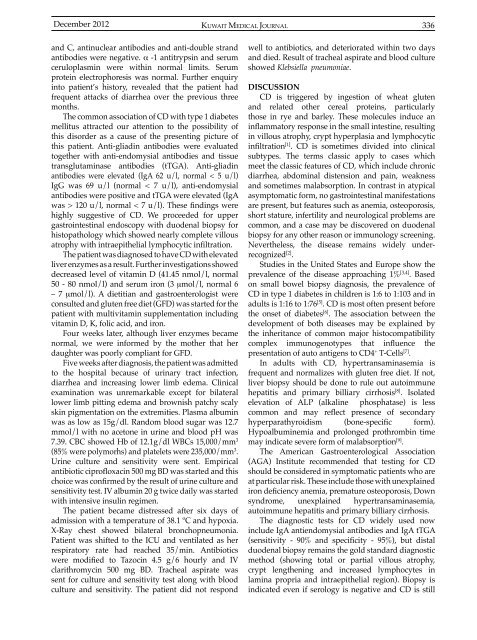Vol 44 # 4 December 2012 - Kma.org.kw
Vol 44 # 4 December 2012 - Kma.org.kw
Vol 44 # 4 December 2012 - Kma.org.kw
Create successful ePaper yourself
Turn your PDF publications into a flip-book with our unique Google optimized e-Paper software.
<strong>December</strong> <strong>2012</strong><br />
KUWAIT MEDICAL JOURNAL 336<br />
and C, antinuclear antibodies and anti-double strand<br />
antibodies were negative. α -1 antitrypsin and serum<br />
ceruloplasmin were within normal limits. Serum<br />
protein electrophoresis was normal. Further enquiry<br />
into patient’s history, revealed that the patient had<br />
frequent attacks of diarrhea over the previous three<br />
months.<br />
The common association of CD with type 1 diabetes<br />
mellitus attracted our attention to the possibility of<br />
this disorder as a cause of the presenting picture of<br />
this patient. Anti-gliadin antibodies were evaluated<br />
together with anti-endomysial antibodies and tissue<br />
transglutaminase antibodies (tTGA). Anti-gliadin<br />
antibodies were elevated (IgA 62 u/l, normal < 5 u/l)<br />
IgG was 69 u/l (normal < 7 u/l), anti-endomysial<br />
antibodies were positive and tTGA were elevated (IgA<br />
was > 120 u/l, normal < 7 u/l). These findings were<br />
highly suggestive of CD. We proceeded for upper<br />
gastrointestinal endoscopy with duodenal biopsy for<br />
histopathology which showed nearly complete villous<br />
atrophy with intraepithelial lymphocytic infiltration.<br />
The patient was diagnosed to have CD with elevated<br />
liver enzymes as a result. Further investigations showed<br />
decreased level of vitamin D (41.45 nmol/l, normal<br />
50 - 80 nmol/l) and serum iron (3 μmol/l, normal 6<br />
– 7 μmol/l). A dietitian and gastroenterologist were<br />
consulted and gluten free diet (GFD) was started for the<br />
patient with multivitamin supplementation including<br />
vitamin D, K, folic acid, and iron.<br />
Four weeks later, although liver enzymes became<br />
normal, we were informed by the mother that her<br />
daughter was poorly compliant for GFD.<br />
Five weeks after diagnosis, the patient was admitted<br />
to the hospital because of urinary tract infection,<br />
diarrhea and increasing lower limb edema. Clinical<br />
examination was unremarkable except for bilateral<br />
lower limb pitting edema and brownish patchy scaly<br />
skin pigmentation on the extremities. Plasma albumin<br />
was as low as 15g/dl. Random blood sugar was 12.7<br />
mmol/l with no acetone in urine and blood pH was<br />
7.39. CBC showed Hb of 12.1g/dl WBCs 15,000/mm 3<br />
(85% were polymorhs) and platelets were 235,000/mm 3 .<br />
Urine culture and sensitivity were sent. Empirical<br />
antibiotic ciprofloxacin 500 mg BD was started and this<br />
choice was confirmed by the result of urine culture and<br />
sensitivity test. IV albumin 20 g twice daily was started<br />
with intensive insulin regimen.<br />
The patient became distressed after six days of<br />
admission with a temperature of 38.1 ºC and hypoxia.<br />
X-Ray chest showed bilateral bronchopneumonia.<br />
Patient was shifted to the ICU and ventilated as her<br />
respiratory rate had reached 35/min. Antibiotics<br />
were modified to Tazocin 4.5 g/6 hourly and IV<br />
clarithromycin 500 mg BD. Tracheal aspirate was<br />
sent for culture and sensitivity test along with blood<br />
culture and sensitivity. The patient did not respond<br />
well to antibiotics, and deteriorated within two days<br />
and died. Result of tracheal aspirate and blood culture<br />
showed Klebsiella pneumoniae.<br />
DISCUSSION<br />
CD is triggered by ingestion of wheat gluten<br />
and related other cereal proteins, particularly<br />
those in rye and barley. These molecules induce an<br />
inflammatory response in the small intestine, resulting<br />
in villous atrophy, crypt hyperplasia and lymphocytic<br />
infiltration [1] . CD is sometimes divided into clinical<br />
subtypes. The terms classic apply to cases which<br />
meet the classic features of CD, which include chronic<br />
diarrhea, abdominal distension and pain, weakness<br />
and sometimes malabsorption. In contrast in atypical<br />
asymptomatic form, no gastrointestinal manifestations<br />
are present, but features such as anemia, osteoporosis,<br />
short stature, infertility and neurological problems are<br />
common, and a case may be discovered on duodenal<br />
biopsy for any other reason or immunology screening.<br />
Nevertheless, the disease remains widely underrecognized<br />
[2] .<br />
Studies in the United States and Europe show the<br />
prevalence of the disease approaching 1% [3,4] . Based<br />
on small bowel biopsy diagnosis, the prevalence of<br />
CD in type 1 diabetes in children is 1:6 to 1:103 and in<br />
adults is 1:16 to 1:76 [5] . CD is most often present before<br />
the onset of diabetes [6] . The association between the<br />
development of both diseases may be explained by<br />
the inheritance of common major histocompatibility<br />
complex immunogenotypes that influence the<br />
presentation of auto antigens to CD4 + T-Cells [7] .<br />
In adults with CD, hypertransaminasemia is<br />
frequent and normalizes with gluten free diet. If not,<br />
liver biopsy should be done to rule out autoimmune<br />
hepatitis and primary billiary cirrhosis [8] . Isolated<br />
elevation of ALP (alkaline phosphatase) is less<br />
common and may reflect presence of secondary<br />
hyperparathyroidism (bone-specific form).<br />
Hypoalbuminemia and prolonged prothrombin time<br />
may indicate severe form of malabsorption [9] .<br />
The American Gastroenterological Association<br />
(AGA) Institute recommended that testing for CD<br />
should be considered in symptomatic patients who are<br />
at particular risk. These include those with unexplained<br />
iron deficiency anemia, premature osteoporosis, Down<br />
syndrome, unexplained hypertransaminasemia,<br />
autoimmune hepatitis and primary billiary cirrhosis.<br />
The diagnostic tests for CD widely used now<br />
include IgA antiendomysial antibodies and IgA tTGA<br />
(sensitivity - 90% and specificity - 95%), but distal<br />
duodenal biopsy remains the gold standard diagnostic<br />
method (showing total or partial villous atrophy,<br />
crypt lengthening and increased lymphocytes in<br />
lamina propria and intraepithelial region). Biopsy is<br />
indicated even if serology is negative and CD is still
















